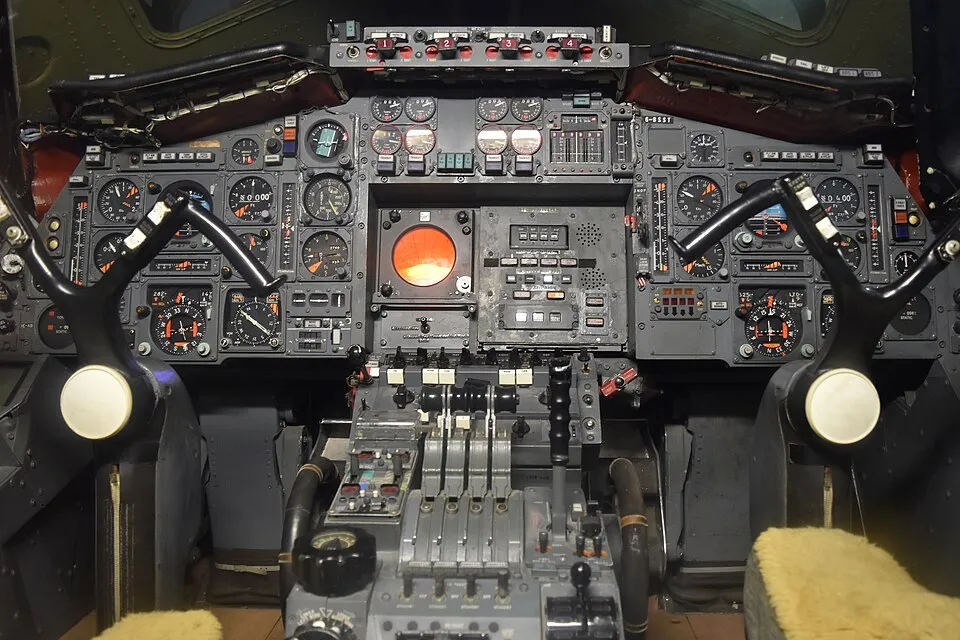The Story of Concorde: From Dream to Supersonic Reality
Introduction: A Supersonic Dream Takes Flight
There was a time when crossing the Atlantic in under three and a half hours was not just a fantasy. It was a reality, embodied in the sharp, needle-nosed elegance of the Concorde — a marvel of engineering and ambition. Born from a collaboration between British and French aerospace pioneers, this aircraft was unlike anything the world had seen before. Sleek, fast, and luxurious, the Concorde was both a technological masterpiece and a symbol of prestige. But its story was not just about speed — it was about political cooperation, engineering genius, and the enduring allure of human ambition. Concorde’s history awaits, let’s begin…..

Night transport of Concorde parts in France, 1967 — massive fuselage section being hauled under streetlights. Public Domain link
The Early Years: Designing the Future
In the early 1960s, Britain’s BAC and France’s Sud Aviation signed an agreement to develop a supersonic passenger jet. The Cold War era was a time of daring aviation goals, and both nations wanted to prove their aerospace prowess. The design was ambitious — a slender fuselage, delta wings, and engines capable of sustained supersonic speeds.
Testing began even before the first prototype was assembled. Engineers studied aerodynamics in wind tunnels, experimenting with materials that could withstand the extreme heat of Mach 2 travel. The project was as much about politics as it was about technology — funding, national pride, and public expectation all played a role.

Another angle of Concorde’s fuselage transport at night in 1967, showing the scale of the operation. Public Domain link

Third view of the 1967 nighttime transport, capturing the rear fuselage section on a multi-axle trailer. Public Domain link
Moving Giants: Transporting the Dream
The sheer size of Concorde’s components meant that moving them from factories to assembly plants was an engineering feat in itself. In May 1968, enormous sections of the aircraft were transported through towns, often at night to avoid traffic. Roads had to be closed, power lines lifted, and police escorts arranged.
Toulouse, France — the heart of Concorde’s French production — became a stage for these mechanical parades. Locals would gather along the streets just to witness the sight of the future rolling past on trailers.

Transport of Concorde components through the streets of Toulouse. 1967. Public Domain link

Another May 1967 transport image, showing a massive wing section moving through narrow streets. Public Domain link
Public Reveal: A New Era of Flight
January 28, 1968, marked a special day in Toulouse — the first public presentation of the Concorde. The crowd, filled with journalists, engineers, and curious locals, witnessed the sleek white fuselage that promised to redefine commercial travel.
The aircraft looked like something out of science fiction — its long, pointed nose, elegant curves, and delta wings stood in stark contrast to the bulky airliners of the time. The name “Concorde” itself symbolized harmony — between two nations, between engineering and design, between ambition and reality.

January 1968 — Concorde presented to the people of Toulouse for the first time. License: Public Domain link

Another 1968 Toulouse presentation image, showing Concorde’s nose section in detail. License: Public Domain link
The First Flight: Breaking the Sound Barrier
On March 2, 1969, the world held its breath. With French test pilot André Turcat at the controls, Concorde 001 roared down the runway and lifted into the sky for its maiden flight. While the first flight was subsonic, the real milestone came later when the aircraft pushed through the sound barrier, smoothly transitioning into supersonic flight.
Among the early passengers and guests on board during the test period was famed aviator Jacqueline Auriol, who experienced the thrill of the aircraft’s unmatched acceleration.

President Georges Pompidou visiting Toulouse in 1971 to support the Concorde program. License: Public Domain link

March 2, 1969 — first Concorde flight with Jacqueline Auriol. License: Public Domain link

Close-up of Concorde on the runway during its early test flights. License: Public Domain link
Engineering Excellence: Inside the Supersonic Bird
Concorde’s Rolls-Royce/Snecma Olympus 593 turbojet engines were a marvel — capable of propelling the aircraft to twice the speed of sound while withstanding extreme heat. The landing gear was robust, designed to absorb the immense forces of high-speed landings, while the cockpit bristled with analog dials and switches, a far cry from modern glass cockpits.
The passenger cabin, although narrower than subsonic jets, was luxuriously appointed. Every journey promised not just speed, but an exclusive experience — fine dining, champagne, and panoramic views of the curvature of the Earth.

Concorde landing at Farnborough — sleek silhouette at touchdown. License: CC BY-SA 2.0 link

Concorde jet engine on display at the Imperial War Museum, Duxford. License: CC BY-SA 2.0 link

British Airways Concorde 102 in flight. License: CC BY-SA 2.0 link

British Airways Concorde 102 at rest on the tarmac. License: CC BY-SA 2.0 link

Concorde in flight against a clear blue sky. License: CC BY-SA 2.0 link

Concorde passenger cabin interior — narrow but elegant. License: CC BY-SA 2.0 link

Cockpit of the Concorde prototype G-BSST — a sea of analog dials. License: CC BY-SA 2.0 link

Concorde’s landing gear and brake assembly on display in Germany. License: CC BY-SA 2.0 link

Rolls-Royce/Snecma Olympus 593 Concorde engine on stand. License: CC BY-SA 3.0 link


